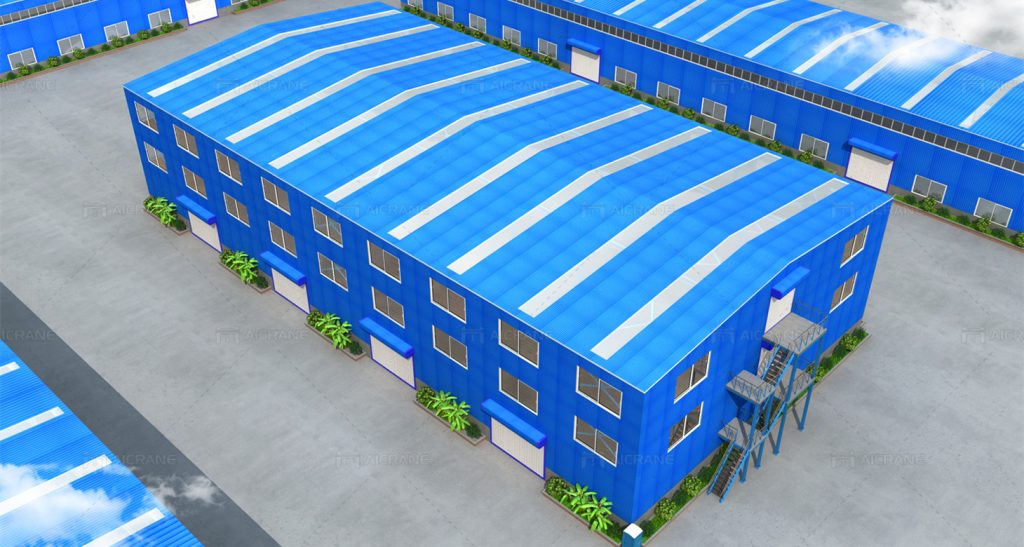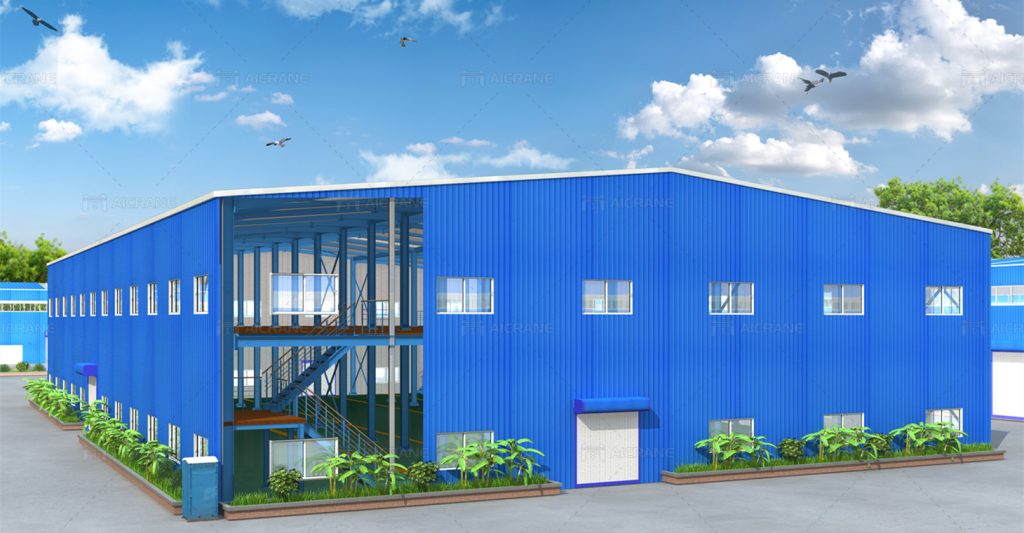Maintaining a steel structure workshop factory is essential for prolonging the lifespan of the facility, ensuring safety, and maintaining productivity. Steel structure workshops, commonly found in manufacturing, warehousing, and industrial settings, offer durability, cost-efficiency, and a versatile layout. However, regular maintenance is necessary to prevent deterioration from factors such as corrosion, wear and tear, and environmental elements. Here’s a comprehensive guide on how to maintain a steel structure workshop factory.

Regular Cleaning and Inspection
A clean facility is essential for early detection of potential issues. Regular cleaning helps prevent buildup of dust, grime, and other materials that can trap moisture and contribute to rust. Set up a consistent cleaning schedule for all areas, especially those prone to collecting dust and debris, like high beams, windows, and ventilation outlets. Some steel structure manufacturer like Aicrane can assist the clients to do that.
Inspections should be conducted at least quarterly. Inspect the structure thoroughly for signs of wear and tear, including rust, loose bolts, and cracks. Attention to detail during inspections can reveal issues before they worsen. Additionally, perform annual inspections of the entire structure with the help of professionals, who can identify problems that may not be immediately visible to untrained eyes.
Rust Prevention and Treatment
Corrosion, particularly rust, is one of the main threats to a steel structure factory. Moisture, salt, and pollutants in the air can accelerate rusting, weakening the structure over time. To prevent and manage rust:
Apply Protective Coatings: Galvanization, painting, and powder coating are effective methods to protect steel surfaces. These coatings act as barriers against moisture and pollutants. If the structure is exposed to harsh environmental conditions, consider using specialized anti-corrosive coatings.
Treat Rust Promptly: If rust appears, it’s important to address it immediately. Use wire brushes, sandblasting, or chemical rust removers to remove the rust. Once cleared, apply a fresh coat of protective paint or sealant to prevent recurrence.
Monitor High-Risk Areas: Certain areas, such as corners, edges, joints, and areas where steel meets concrete, are more susceptible to rust. Give extra attention to these sections during inspections.
Structural Integrity Checks
Maintaining the structural integrity of the workshop is crucial for safety and functionality. Regularly check all load-bearing beams, joints, columns, and braces to ensure they are in sound condition. Signs that indicate a compromised structure include:
Deformed or Bent Steel: Excessive loads or impacts can bend or deform steel components. If any bending or warping is observed, assess the area immediately to determine if repairs are necessary.
Loose or Missing Fasteners: Over time, bolts, screws, and welds can loosen due to vibrations, temperature changes, or normal wear. Tighten any loose fasteners and replace missing or damaged ones.
Foundation Checks: Cracks in the foundation can weaken the overall structure. Ensure that the foundation is stable and address any cracks promptly with professional repairs.

Roof and Gutter Maintenance
Roofs and gutters play a vital role in protecting a steel structure workshop factory from water damage. Regular maintenance of these components helps prevent water accumulation, which can lead to corrosion and structural damage.
Inspect the Roof for Leaks: Check for any signs of leaks or water damage on the roof and ceiling. Small leaks can lead to significant damage if not addressed. Repair or replace any damaged roof sections, and ensure the roof is well-sealed.
Clean the Gutters: Gutters and downspouts can become clogged with leaves, dirt, and debris, leading to water overflow. Clean gutters regularly, especially during seasons with high rainfall or strong winds. Ensure that water flows smoothly away from the structure to prevent it from pooling around the foundation.
Check for Roof Rust: Since the roof is often the most exposed part of the structure, it is susceptible to rust. Conduct regular inspections and treat any rust spots immediately.
Control of Temperature and Humidity
Extreme temperature fluctuations and high humidity can impact steel structures, causing expansion, contraction, and condensation. Temperature and humidity control is essential in regions with varying climates.
Install Insulation: Insulating the workshop can help maintain a consistent temperature and reduce the risk of condensation. Insulation also helps prevent heat loss during colder months, making the facility more energy-efficient.
Use Dehumidifiers: In humid climates, dehumidifiers can be installed to control moisture levels, which helps reduce the risk of rust and corrosion.
Ventilation: Ensure the workshop is well-ventilated to promote air circulation. Proper ventilation reduces humidity levels and minimizes the chances of moisture buildup on steel surfaces.
Proper Load Management
Steel structure workshops are often designed to handle heavy equipment and materials, but overloading can strain the structure. Avoid placing excessive loads on beams or shelves that were not designed to bear heavy weights. If the layout of the workshop changes or new equipment is added, assess whether the existing structure can handle the additional load.
Floor and Wall Maintenance
Maintaining floors and walls is as important as maintaining the steel frame. Floors in steel structure workshops are typically concrete, which can crack or chip over time due to the movement of heavy machinery or pallets.
Repair Floor Cracks: Cracks in the concrete floor should be addressed immediately to prevent them from widening and compromising the structural integrity. Use industrial-grade fillers or resurface the floor if necessary.
Inspect Wall Panels: Steel structure workshops often have steel or composite wall panels. Check for dents, rust, or punctures in these panels. Repair any damage to prevent moisture from entering and causing rust.
Electrical and Plumbing System Checks
Electrical and plumbing systems also require regular maintenance to ensure smooth operations and safety.
Inspect Electrical Wiring: Faulty or damaged wiring can pose a fire risk. Regularly inspect all electrical installations, including lights, machinery connections, and outlets. Replace damaged wires and ensure that all installations meet safety standards.
Check Plumbing for Leaks: Any water leakage in the plumbing system can lead to moisture accumulation, which accelerates corrosion. Inspect plumbing fixtures, pipes, and drainage systems for leaks and repair them promptly.
Regular Training for Maintenance Staff
Proper maintenance involves both scheduled checks and immediate response to any issues that arise. Providing training for maintenance staff ensures they are equipped to handle specific maintenance tasks and can recognize potential problems early. Trained personnel can carry out minor repairs, prevent small issues from escalating, and ensure the facility is kept in optimal condition.
Record-Keeping and Maintenance Schedule
Maintaining a record of all maintenance activities, inspections, and repairs is crucial for tracking the condition of the steel structure workshop factory. Use a digital or physical log to document:
Inspection dates and findings
Repairs conducted, including the location and type of repairs
Replacement of parts or materials
Any issues or observations that require follow-up
A well-organized maintenance schedule helps streamline tasks, allocate resources effectively, and ensure all necessary checks are conducted on time.
A steel structure workshop factory is a valuable asset that requires proactive maintenance to ensure longevity, safety, and functionality. By implementing a structured maintenance plan that includes regular inspections, rust prevention, structural integrity checks, and environmental control, you can protect your investment and keep the workshop operating efficiently. Establishing a maintenance culture within the facility will not only extend its life but also improve overall productivity and workplace safety.